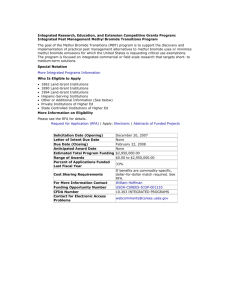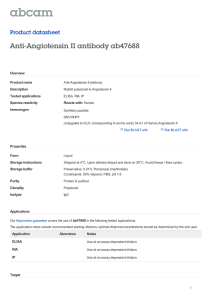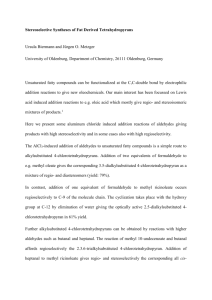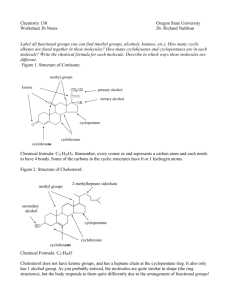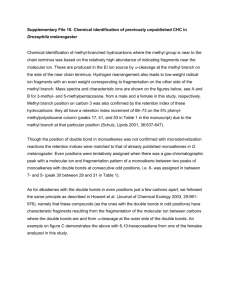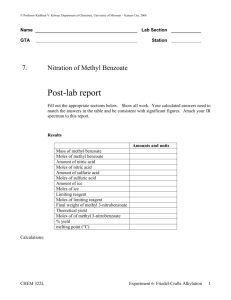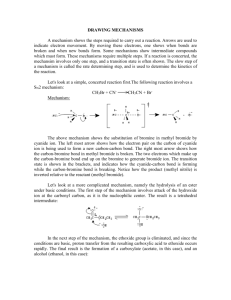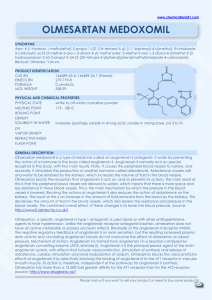rescinnamine - Chemicalland21.com
advertisement
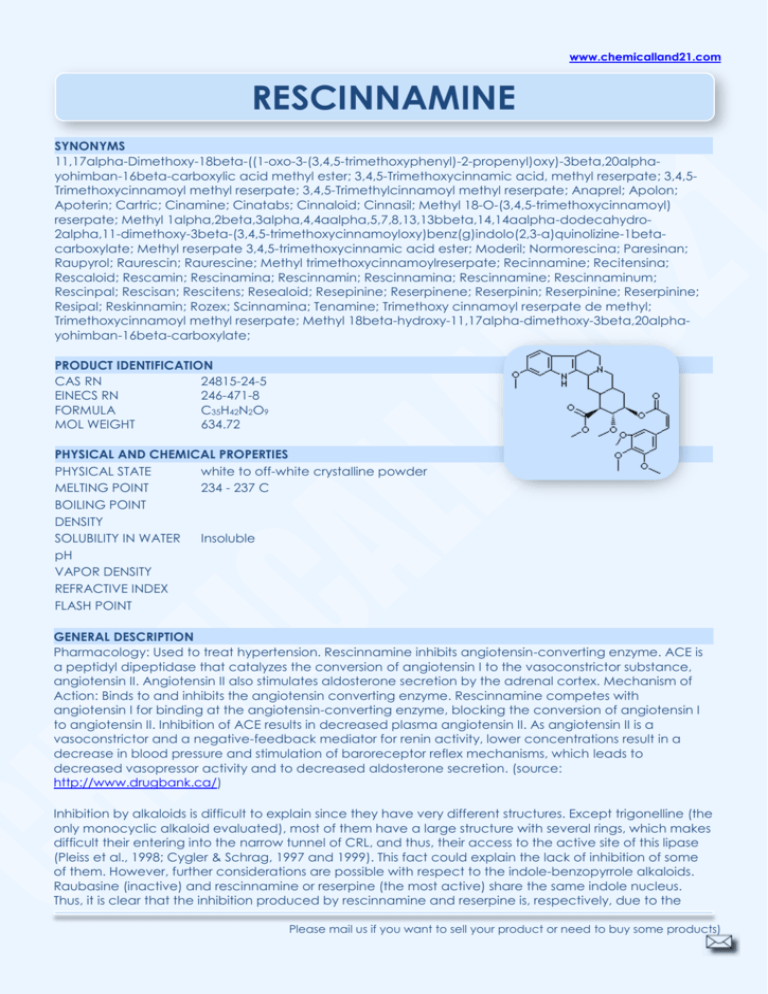
www.chemicalland21.com RESCINNAMINE SYNONYMS 11,17alpha-Dimethoxy-18beta-((1-oxo-3-(3,4,5-trimethoxyphenyl)-2-propenyl)oxy)-3beta,20alphayohimban-16beta-carboxylic acid methyl ester; 3,4,5-Trimethoxycinnamic acid, methyl reserpate; 3,4,5Trimethoxycinnamoyl methyl reserpate; 3,4,5-Trimethylcinnamoyl methyl reserpate; Anaprel; Apolon; Apoterin; Cartric; Cinamine; Cinatabs; Cinnaloid; Cinnasil; Methyl 18-O-(3,4,5-trimethoxycinnamoyl) reserpate; Methyl 1alpha,2beta,3alpha,4,4aalpha,5,7,8,13,13bbeta,14,14aalpha-dodecahydro2alpha,11-dimethoxy-3beta-(3,4,5-trimethoxycinnamoyloxy)benz(g)indolo(2,3-a)quinolizine-1betacarboxylate; Methyl reserpate 3,4,5-trimethoxycinnamic acid ester; Moderil; Normorescina; Paresinan; Raupyrol; Raurescin; Raurescine; Methyl trimethoxycinnamoylreserpate; Recinnamine; Recitensina; Rescaloid; Rescamin; Rescinamina; Rescinnamin; Rescinnamina; Rescinnamine; Rescinnaminum; Rescinpal; Rescisan; Rescitens; Resealoid; Resepinine; Reserpinene; Reserpinin; Reserpinine; Reserpinine; Resipal; Reskinnamin; Rozex; Scinnamina; Tenamine; Trimethoxy cinnamoyl reserpate de methyl; Trimethoxycinnamoyl methyl reserpate; Methyl 18beta-hydroxy-11,17alpha-dimethoxy-3beta,20alphayohimban-16beta-carboxylate; PRODUCT IDENTIFICATION CAS RN 24815-24-5 EINECS RN 246-471-8 FORMULA C35H42N2O9 MOL WEIGHT 634.72 PHYSICAL AND CHEMICAL PROPERTIES PHYSICAL STATE white to off-white crystalline powder MELTING POINT 234 - 237 C BOILING POINT DENSITY SOLUBILITY IN WATER Insoluble pH VAPOR DENSITY REFRACTIVE INDEX FLASH POINT GENERAL DESCRIPTION Pharmacology: Used to treat hypertension. Rescinnamine inhibits angiotensin-converting enzyme. ACE is a peptidyl dipeptidase that catalyzes the conversion of angiotensin I to the vasoconstrictor substance, angiotensin II. Angiotensin II also stimulates aldosterone secretion by the adrenal cortex. Mechanism of Action: Binds to and inhibits the angiotensin converting enzyme. Rescinnamine competes with angiotensin I for binding at the angiotensin-converting enzyme, blocking the conversion of angiotensin I to angiotensin II. Inhibition of ACE results in decreased plasma angiotensin II. As angiotensin II is a vasoconstrictor and a negative-feedback mediator for renin activity, lower concentrations result in a decrease in blood pressure and stimulation of baroreceptor reflex mechanisms, which leads to decreased vasopressor activity and to decreased aldosterone secretion. (source: http://www.drugbank.ca/) Inhibition by alkaloids is difficult to explain since they have very different structures. Except trigonelline (the only monocyclic alkaloid evaluated), most of them have a large structure with several rings, which makes difficult their entering into the narrow tunnel of CRL, and thus, their access to the active site of this lipase (Pleiss et al., 1998; Cygler & Schrag, 1997 and 1999). This fact could explain the lack of inhibition of some of them. However, further considerations are possible with respect to the indole-benzopyrrole alkaloids. Raubasine (inactive) and rescinnamine or reserpine (the most active) share the same indole nucleus. Thus, it is clear that the inhibition produced by rescinnamine and reserpine is, respectively, due to the Please mail us if you want to sell your product or need to buy some products) www.chemicalland21.com RESCINNAMINE [(2E)-1-oxo-3-(3,4,5-trimethoxyphenyl)-2-propenyl]oxy or the [(3,4,5-trimethoxybenzoyl)oxy] groups bound to C18 in the indole nucleus of the alkaloid. As we suggested before for the carbohydrate chains of saponins, we think that these two groups can enter the tunnel of CRL and interfere with the active site of the enzyme, while the indole nucleus remains outside the tunnel, probably associated with the hydrophobic patch located under the tunnel entrance or with other hydrophobic structures of CRL surface (Cygler & Schrag, 1997 and 1999). This hypothesis is supported by the fact that rescinnamine, whose longer group could enter more deeply into the tunnel of CRL than that of reserpine, is itself more active than reserpine. (source: http://www.tdx.cesca.es/) STABILITY AND REACTIVITY STABILITY Stable under normal conditions. Light sensitive. May cause reproductive and fetal INCOMPATIBLE MATERIALS DECOMPOSITION PRODUCTS POLYMERIZATION SAFETY HAZARD NOTES EYE SKIN INGESTION INHALATION CHRONIC NFPA RATING effects. May change color when exposed to light or air. Strong oxidizing agents, direct light Carbon monoxide, Carbon dioxide, Nitrogen oxidese Will not occur May be harmful if swallowed. May cause eye and skin irritation. Light sensitive. May cause reproductive and fetal effects. Target Organ(s): Central nervous system. May cause eye irritation. May cause skin irritation. May be harmful if absorbed through the skin. May cause central nervous system depression. May be harmful if swallowed. Overexposure may cause excessive drowsiness, hypotension, fatigue, weakness, insomnia, nightmares, excitement, irrational behavior, and parkinsonian rigidity. May cause rhinitis. Causes nasal congestion, increased bronchiolar secretion and constriction, edema, possible heart failure. Aggrivates dermatological disorders by cutaneous vasodilation. Exposure may cause nosebleeds, insomnia, paradoxical anxiety, nervousness, dryness of mouth, sialorrhea, decreased libido, gynecomastia, and estrogenic effects in females. Health: 1, flammability: 0, reactivity: 0 SALES SPECIFICATION APPEARANCE white to off-white crystalline powder ASSAY 98.0% min MELTING POINT 234 - 237 C TRANSPORT & REGULATORY INFORMATION UN NO. HAZARD CLASS PACKING GROUP HAZARD SYMBOL XN RISK PHRASES 20/21/22 SAFETY PHRASES 24/25 PACKING Please mail us if you want to sell your product or need to buy some products) www.chemicalland21.com RESCINNAMINE PRICE Please mail us if you want to sell your product or need to buy some products)
